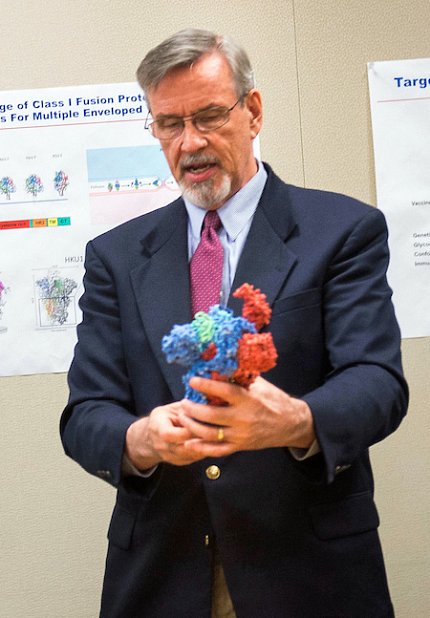New Technologies Speed Up Covid-19 Vaccine Research

Photo: Lisa Helfert
NIAID researchers are using new technologies to develop a vaccine against Covid-19 as fast as possible, said Dr. Barney Graham, Vaccine Research Center deputy director.
“Since 2009, a number of key technologies have emerged. They have increased our capacity for making new vaccines,” he said during an NIH Covid-19 scientific interest group lecture on Apr. 22.
Coronaviruses are a family of spherical viruses that have crown-like protein spikes on their surfaces. The spikes bind to the surface of cells, allowing the virus to enter. Four types of coronavirus routinely circulate in human populations. They cause up to 30 percent of common colds.
Over the past 2 decades, 3 new types of coronavirus emerged from animal reservoirs: SARS-CoV, MERS-CoV and SARS-CoV-2, the virus that causes Covid-19. SARS-CoV first appeared in fall of 2002. Back then, Graham said, “It took until March 2003 to diagnose it as a virus and another month to get it sequenced.” It had a fatality rate of 10 percent. By the summer, the virus disappeared and “people stopped thinking about it.”
Ten years later, MERS-CoV appeared in the Middle East. It had a fatality rate of almost 40 percent, but it didn’t spread, except for one outbreak in South Korea. “Again, the disease didn’t spread that far and there was not much of a motivation to make commercial vaccine products,” he noted.
It seemed obvious that more coronaviruses would emerge, Graham said. Advances in cryo-electron microscopy allowed researchers to see viral proteins in much greater detail. Now, they could solve the atomic-level structure of coronavirus spike proteins. The advance gave them the ability to define vaccine targets. From there, they can stabilize the spike protein and use it to induce antibodies that could neutralize the virus.
“Three or 4 years ago, we thought we knew a generalizable approach for how to make coronavirus vaccine antigen. If anything ever happened again, we wanted to be able to deliver it quickly,” he said.

So, NIAID began to collaborate with the biotechnology company Moderna, Inc., that had developed an “mRNA technology platform” that allowed scientists to quickly manufacture a potential vaccine. The platform is based on the idea that mRNA can be made, purified and prepared as a product regardless of the protein being expressed. With the mRNA expressing the spike protein, scientists would be able to inject mRNA into a cell where the protein would be made and spur antibody production.
Just weeks after SARS-CoV-2 was isolated and genetically sequenced, NIAID scientists, in partnership with Moderna, began a phase 1 clinical trial evaluating a potential vaccine based on a stabilized spike protein using mutations identified in their prior studies on other coronaviruses. The vaccine directs the body’s cells to express a virus protein, with the goal of causing a strong immune response.

Photo: CDC
“This was the first time I have seen manufacturing outpace the clinical and regulatory processes,” Graham said.
They were able to move so quickly because of their past research on coronaviruses like SARS and MERS. Once the scientists determined the genetic sequence of SARS-CoV-2, they rapidly defined its atomic level structure. That gave them the confidence that they were making the right thing in the right conformation using the mRNA platform; testing in mice showed that it could induce strong immune responses.
“We are going to have antibody data—at least on the first few subjects—by the middle of May,” he said [hopeful preliminary data was later confirmed].
The vaccine candidate being tested by NIAID and Moderna is just one of 115 vaccines being developed in different parts of the world. Graham believes “we really need about 10 good vaccine programs.” Having so many candidates will make it difficult to identify the best ones.
He said that a prototype-pathogen approach, similar to what was done for MERS-CoV to inform how to respond to any other coronavirus, could be used for the other 24 virus families that are known to infect humans. Within those families there are about 100 known viruses that are recognized as potential threats.
“New technologies are transforming vaccinology. By combining the precision of atomic-level antigen design with the speed of platform manufacturing, a new paradigm for preparing for and responding to emerging viruses is possible,” Graham concluded.
To watch the entire lecture, visit https://videocast.nih.gov/summary.asp?live=36377&bhcp=1.
